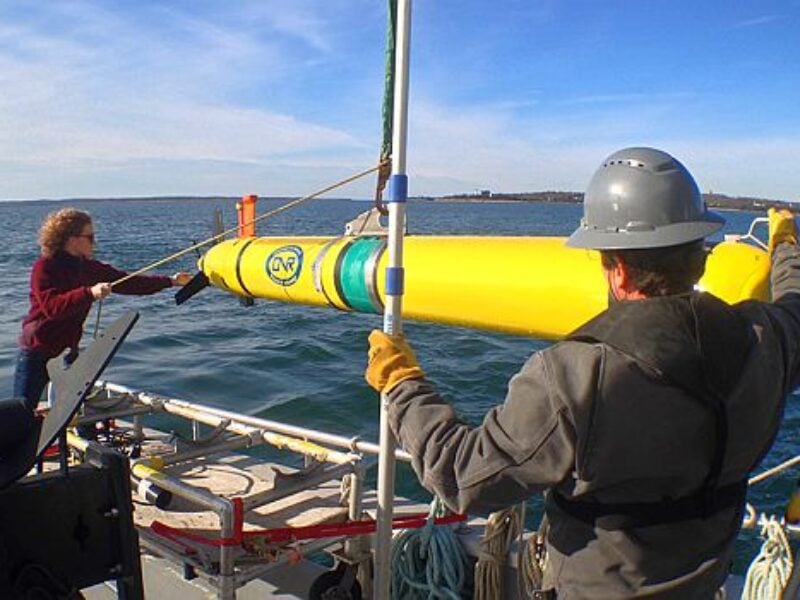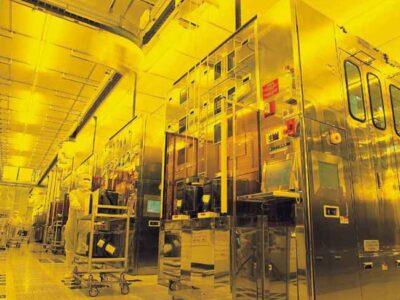
New equations help autonomous marine robots navigate
Increasingly being used to explore and observe the world’s oceans, AUVs can help determine where, when, and what to sample for the most informative data, and how to optimally reach sampling locations. With that in mind, MIT researchers have developed systems of mathematical equations that forecast the most informative data to collect for a given observing mission, and the best way to reach the sampling sites.
With their method, say the researchers, they can predict the degree to which one variable – such as the speed of ocean currents at a certain location – reveals information about some other variable, such as temperature at some other location. If the degree of “mutual information” between two such variables is high, an AUV can be programmed to go to certain locations to measure one variable, to gain information about the other.
“Not all data are equal,” says Arkopal Dutt, a graduate student in MIT’s Department of Mechanical Engineering. “Our criteria allow the autonomous machines to pinpoint sensor locations and sampling times where the most informative measurements can be made.”
To determine how to safely and efficiently reach ideal sampling destinations, the researchers developed a way to help AUVs use the uncertain ocean’s activity by forecasting out a dynamic three-dimensional region of the ocean that an AUV would be guaranteed to reach within a certain time, given the vehicle’s power constraints and the ocean’s currents. The team’s method enables a vehicle to surf currents that would bring it closer to its destination, and avoid those that would throw it off track.
“AUVs are not very fast, and their autonomy is not infinite, so you really have to take into account the currents and their uncertainties, and model things rigorously,” says Pierre Lermusiaux, professor of mechanical engineering and ocean science and engineering at MIT, who led the research. “Machine intelligence for these autonomous systems comes from rigorously deriving and merging governing differential equations and principles with control theory, information theory, and machine learning.”
The researchers used the equations and an ocean model they developed – called Multidisciplinary Simulation, Estimation, and Assimilation Systems (MSEAS) – in sea experiments to successfully forecast fields of mutual information and guide actual AUVs. When the researchers compared their reachability forecasts with the routes of actual AUVs observing a region of the Arabian Sea, they found their predictions matched where the vehicles were able to navigate, over long periods of time.
To create their model, the researchers developed path-planning algorithms from fundamental principles with the ocean in mind. They modified an existing equation – known as the Hamilton-Jacobi equation – to determine the furthest perimeter a vehicle is guaranteed to reach in a given amount of time. The equation is based on three main variables: time, a vehicle’s specific propulsion constraints, and advection – or the transport by the dynamic ocean currents, a variable which the group predicts by using its MSEAS ocean model.
With the new system, AUVs can map out the feasible most informative paths and adapt their sampling plans as the uncertain ocean’s currents shift over time. In actual open-ocean testing, say the researchers, gliders and floats ended up where desired and within the probabilistic areas predicted.
The system was also used to plan trajectories that would get an AUV to a certain location in the shortest amount of time, given the forecast ocean current conditions. They tested these “time-optimal paths” in real time by holding “races” between identical propelled AUVs off the coast of Martha’s Vineyard – in each race, one AUV’s course was determined by the calculated time-optimal path, while another vehicle followed a path with the shortest distance to the same destination.
In every race, say the researchers, the AUV operating under the researchers’ forecast reached its destination first, performing about 15% faster than the competing AUV. The forecast helped the winning AUV avoid strong currents that at times acted to block the other AUV.
“Autonomous marine robots are our scouts, braving the rough seas to collect data for us,” says mechanical engineering graduate student Deepak Subramani. “Our math equations help the scouts reach the desired locations and reduce their energy usage by intelligently using the ocean currents.”
Among other applications, the researchers will be applying their ocean forecasting methods to help guide observations off the coast of India, where vehicles will be used to monitor fisheries to provide a potentially low-cost management system. For more, see “Optimal Planning and Sampling Predictions for Autonomous and Lagrangian Platforms and Sensors in the Northern Arabian Sea.” (PDF)
Related articles:
Soft robotic fish offers close-up view of underwater life
Ocean research drones set sail for South Pacific
Power scavenging robot ‘squid’ to explore extraterrestrial oceans
Robot ship to navigate Pacific in 2019
‘Living sensors’ hold promise for ocean surveillance, says DARPA
Powering autonomous marine applications
 If you enjoyed this article, you will like the following ones: don't miss them by subscribing to :
eeNews on Google News
If you enjoyed this article, you will like the following ones: don't miss them by subscribing to :
eeNews on Google News



